
Preflight tools in Acrobat 8: Not just for print and prepress
By Carl Young – January 4, 2007
Nestled away in the Advanced Menu of Acrobat 8 Professional is the world of preflighting, which is unknown country for most business users of Acrobat. Preflighting is the term used in the commercial printing/graphic arts world for checking your files before printing them. Although the Preflight dialog box (Advanced > Preflight) may look a bit intimidating, don’t worry. If you just focus on a few things and don’t obsess about knowing what every option is for, you will find some very helpful tools.
New in Acrobat 8 Professional is the capability to actually repair a PDF. Previous versions were essentially limited to reporting errors only. Acrobat 8 also introduces the concept of a “droplet,” for desktop batch processing of files.
The Preflight tools may be designed with the professional printer in mind, but there’s a lot here for everyone who uses PDF. For example:
- You can identify where missing fonts are located.
- You can troubleshoot many other issues.
- You can check compliance with industry standards, or create your own internal standard.
- You can automate error detection and repair with “droplets.”
Missing fonts
Missing fonts represent one of the biggest struggles Acrobat users face. Missing fonts can change the way a document looks, because they requires Acrobat to guess what the absent font looks like, which can result in critical errors. For example, a special math symbol could change if the math font is missing and Acrobat substitutes a replacement character. In my opinion, you should always embed fonts, unless you have a good reason not to. NOTE: Some font vendors don’t permit embedding, or they may require additional fees.
You can see which fonts are being used in Acrobat by choosing File > Document Properties > Fonts. If you see a line that says “Actual Font,” then a font has been substituted.
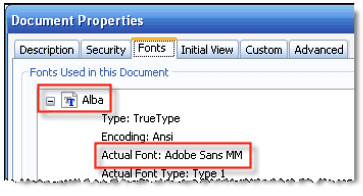
Figure 1: "Actual font" means a font has been substituted.
So where is the missing font? And how often does it appear? Those key pieces to the troubleshooting of missing fonts are not available in the Document Properties window. Your key to discovering the exact location of the missing fonts is inside Acrobat Professional’s Preflighting tools.
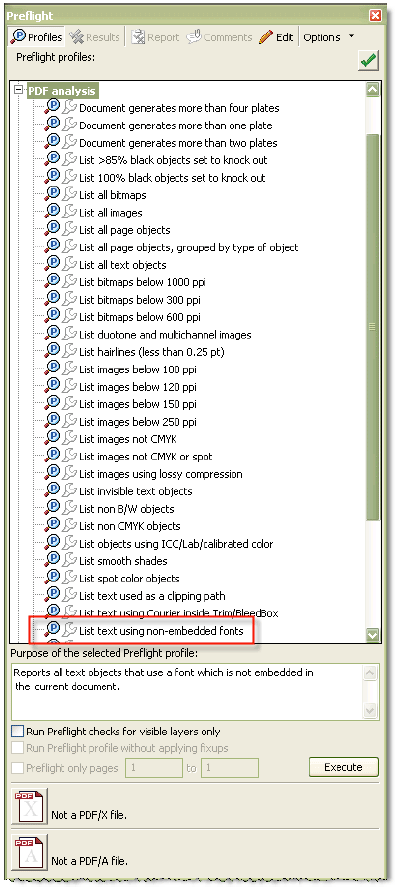
Figure 2. List text using non-embedded fonts.
If you choose Acrobat > Advanced >Preflight, you will see a list of profile groups. Expand the PDF analysis group and select List text using non-embedded fonts and click the Execute button. Once the report has run, enable the Show selected page object in Snap view option, and expand any messages indicating missing fonts. Click on a message and the words and pages where the missing fonts occur will be highlighted.
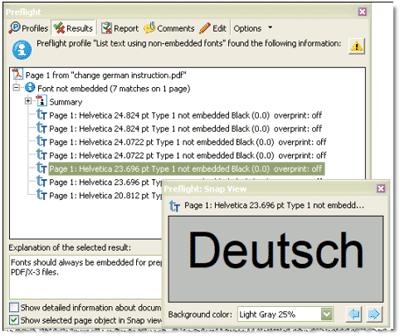
Figure 3. A list of words and pages where missing fonts occur.
Once you have identified a missing font, you can change your Adobe PDF settings to embed fonts, or use the TouchUp Text Tool. If the font manufacturer doesn’t permit embedding, then look for a substitute you can embed. See Customize Adobe PDF settings and Embed fonts using the TouchUp Text tool in Complete Acrobat Help for details.
Troubleshooting other common issues
The Preflight profiles in Acrobat 8 Professional cover a lot of ground, and will let most users troubleshoot and fix many of the most common issues. Among them:
- Check PDF version compatibility back to Acrobat 3
- Create a list of any low-resolution (below 100 ppi) graphics
- Create a list of invisible text objects that might be obscuring graphics or inappropriately showing up in Search results
- Convert color graphics to grayscale
- Flatten comments and form fields
- Remove all comments
Profiles with a solid Preflight Profile icon and a grayed-out wrench indicate you will receive a report, but that the profile will not change the PDF.
![]()
A solid wrench and a grayed-out Preflight Profile icon means the profile will change the file, but not generate a report.
![]()
Acrobat can create a new PDF with report information in it, or you can press the Comments button once the report has run to insert report information as comments into the PDF.
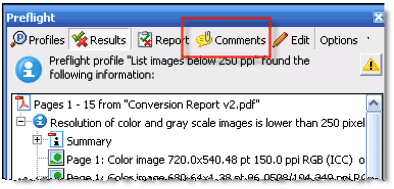
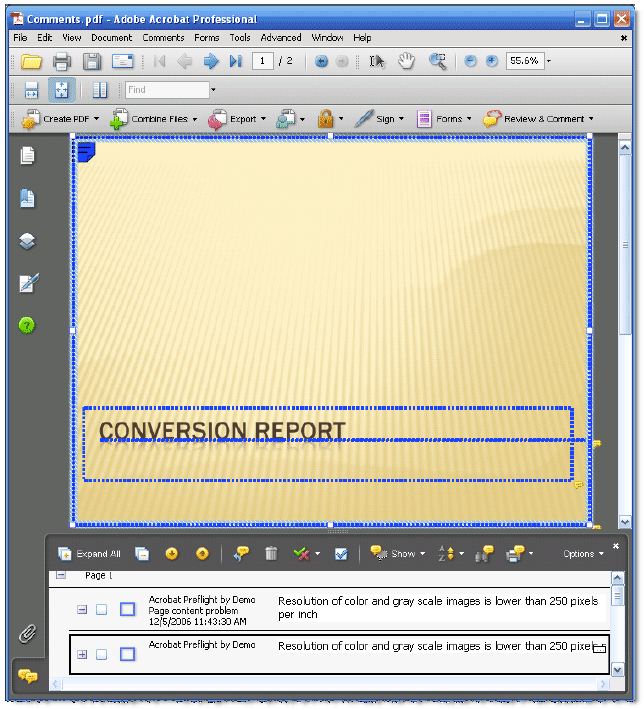
Figure 4. Press the Comments button to insert report information into the PDF.
How do you remove all these comments? Run the Remove all annotations profile found in the PDF fixups group. Or in the Preflight window choose Options > Remove Preflight Comments.
Check for industry and standards compliance
PDFs are so essential for many businesses that several industries have created standards. Included in Acrobat 8 Professional’s list are profiles that comply with the international archive standard (PDF/A) and the international printing standard (PDF/X). For more information on standards, see About PDF/X and PDF/A standards in Complete Acrobat Help.
While approved standards are great for people and industries who can use and benefit from those particular settings, PDF/A and PDF/X are not ideal for everyone. What happens if your company or industry has an internal standard that isn’t in the default Preflight Profile list? You can create your own.
Let’s say that your industry requires that PDFs exchanged between companies and clients must have the following four characteristics:
- Compatibility with Acrobat 5 or higher
- Graphics must be at least 100 ppi, but no more than 300 ppi
- All fonts must be embedded
- No layers are permitted
Everything else, including JavaScripts, form fields, attachments and so on are permitted. Let’s create a custom profile.
1. Click the Edit button in the Preflight window.

2. Then click the Plus sign in the Edit Profile window.
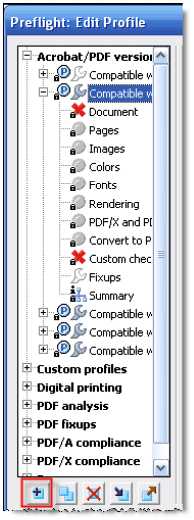
3. Give the profile a name, brief description and assign it to a group. Custom profiles is a good choice.
Now you will work your way down the panel on the left side of the Edit Profiles window, starting with Images.
1. Move to the Images item and set the resolution of color, grayscale and bitmap images to a minimum of 100 and a maximum of 300.

2. Move to Fonts and set Font is not embedded option to Error.
3. Move to Custom Checks and type layers in the search box to the left of All available custom checks.
4. When you see Layers used highlighted, click on the blue, left arrow to move Layers used to the Custom checks used in this profile window.
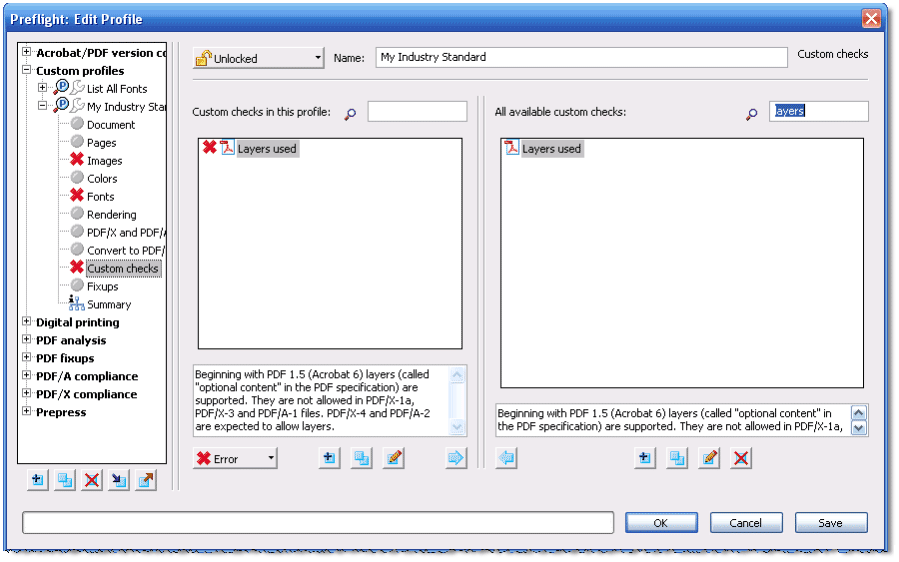
5. In the Edit Profile window, click on the plus sign to create a new custom check.
6. Enter version in the search box of the New Check window.
7. Highlight PDF format version.
8. Set the pull down menu to greater than or equal to.
9. Enter 1.4 (PDF Reference version number for Acrobat 5) in the Number: box.
10. Enter PDF 1.4 or higher in the When check fires, report as box.

11. Click OK and then OK again. Your custom profile is now ready to run.
You may have noticed an option in the Document section of the Edit Profiles window that says The PDF document uses features that require at least and then options for various versions of Acrobat. Unfortunately, the levels listed in that section are for PDF/A compliance, and will check for many more things than the version number of the document. So you can’t use it just to check for the version number of a PDF.
In the section above, you created a custom check that just looks at whether the document has a PDF version number of 1.4 or higher, and ignores all the other stuff.
Automate error reporting
Now that you have created your custom report, wouldn’t it be nice if you could easily check a group of files at once? You can, with Acrobat 8 Professional’s new droplet feature.
1. Choose Create Preflight Droplet from the Options menu in the Preflight dialog box.
2. Choose your preflight profile from the pull-down menu.
3. Specify settings for handling the PDFs after the preflight inspection. In this case we will just use the default, which creates a PDF summary of any errors found.
4. Save the droplet on your desktop.

Now you can select one or more PDFs and drop them on the droplet to check the files all at once.
Conclusion
I hope you can see the value of preflight profiles for people outside the commercial printing world. You have to wade through some print-industry jargon in the profiles, but the profiles contain some powerful troubleshooting tools.
I know people who have spent hours or days looking for missing fonts, hidden layers and other PDF gremlins. The preflight profiles can quickly identify and isolate missing fonts; check your PDFs for compliance with industry or custom standards; and even check a group of files with a Preflight Droplet.
Once you start using preflight profiles for PDF troubleshooting and inspection, you’ll wonder how you ever got along without them.